15 Foods to STOCKPILE That NEVER Expire!
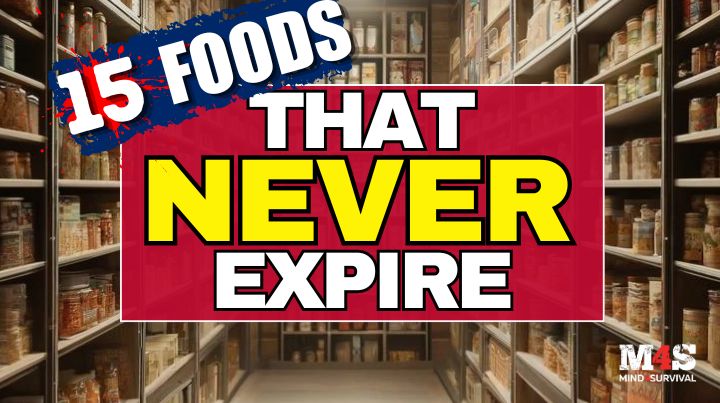

Podcast: Play in new window | Download
Imagine never having to throw away food again. That's every prepper's dream. Guess what? It is possible, and in this article, I'll discuss 15 foods to stockpile that never expire. This doesn't mean they will last millennia, but many of these foods may outlive you.
It's a fact that during uncertain times and emergencies, having a stockpile of survival food can provide peace of mind, knowing that you and your loved ones' nutrition needs are taken care of. While some foods, such as dehydrated fruit and boxes of processed food, have long shelf lives, some foods are the champions of survival and outlast most others by decades. These foods are crucial for any preparedness-minded person who wants to ensure their survival food pantry is ready for the long haul.
In this article, I will discuss 15 foods that, when stored properly, will last indefinitely. That means you can store them away without worrying that they will expire within a year or two or go bad because checking them slipped your mind.
1. Canned Meat
Canned meat has excellent longevity. While fresh meat requires refrigeration and quickly spoils, canned meat can remain edible for years. This is because the canning process cooks the meat thoroughly and seals it away from the air, preventing the growth of bacteria and spoilage.
Typical meats like beef, chicken, and pork are available in canned form. When canned, they retain most of their nutrients and caloric value, making them an excellent source of energy and protein in times of need. That's important because protein is crucial for survival and is often overlooked in favor of carbohydrate-based foods like rice, beans, and pasta. Protein is vital for maintaining muscle mass, repairing tissues, and supporting immune function. Therefore, adequate protein intake is essential to maintaining strength and resilience during times of stress and physical challenge.
Canned meat is pre-cooked, which means you can eat it straight from the can—a benefit when your time and ability to cook might be limited during a disaster. While canned meats are generally safe, it's important to know how to identify signs of spoilage. Always inspect the can before use and give the meat a smell test after opening—it should smell fresh and meaty, not sour or unpleasant. Never consume canned meat if the can is bulging, leaking, or rusting, as these are signs of bacterial contamination.
When selecting canned meat for your emergency supplies, consider variety. Beyond the usual chicken and beef, options like turkey and exotic meats can provide different flavors and nutritional profiles. This variety can help prevent food fatigue and ensure you get a wide range of nutrients.
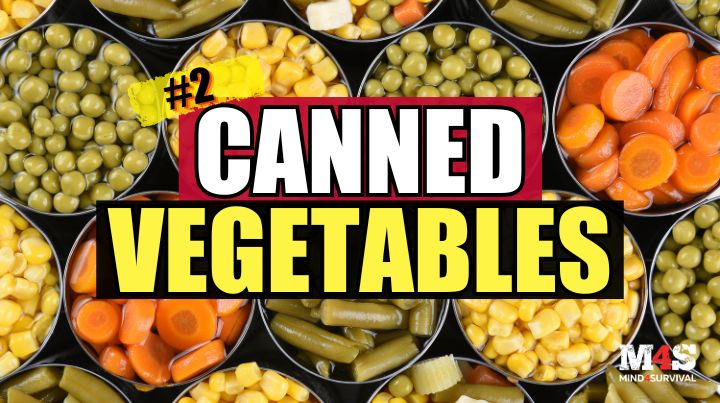
2. Canned Vegetables
Among the many long-term food choices available, canned vegetables stand out as a stellar option for several reasons. Notably, they are one of the food items that can practically last forever under the right conditions.
Canned vegetables are an excellent food pantry choice because the canning process seals in the freshness and nutrients of the vegetables at their peak. This means you're not just storing food but preserving its nutritional value. Whether it's green beans, carrots, corn, or peas, canned vegetables can remain safe to eat far beyond their ‘best by' dates, provided they are correctly stored and remain unopened in a cool, dry place.
Another reason to include canned vegetables in your survival pantry is their versatility. They can be used in various dishes, from stews and soups to mixed in a bowl of rice, enhancing your meals' flavor and nutritional content when fresh produce may not be an option. Like canned meat, canned vegetables can be eaten without cooking. So, if you are eating on the run or don't want to start a fire, all you need to do is open the can and dig in.
Even though canned vegetables can last a long time, rotating your supply and using them regularly ensures that you maintain a fresh stockpile and don't end up with expired goods. This practice also helps you stay familiar with the tastes and uses of your stored food, which is crucial in ensuring that you maximize the benefit of your preparedness pantry during an emergency.
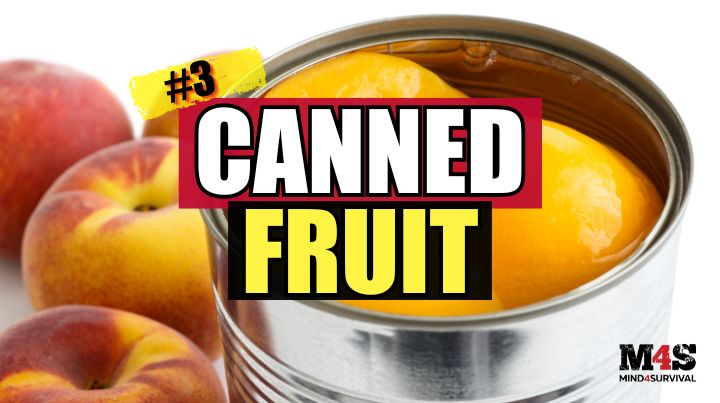
3. Canned Fruits
One regularly overlooked food staple when planning long-term food storage is canned fruit. Canned fruit is tasty, enduring, and surprisingly versatile, and it maintains its taste, vitamins, and nutritional value for years.
Having canned fruit stocked away is not all about survival or nutrition. In a disaster situation where food is in short supply, popping open a can of fruit can add a well-anticipated reward at the end of a difficult day.
Beyond being a rewarding snack, canned fruits can be used to make pies, be mixed into salads, or serve as a sweet option alongside your other long-term food storage meals. The fact that they require no refrigeration adds to their appeal, especially in scenarios where power is a luxury and the ability to acquire fresh fruit may be non-existent.
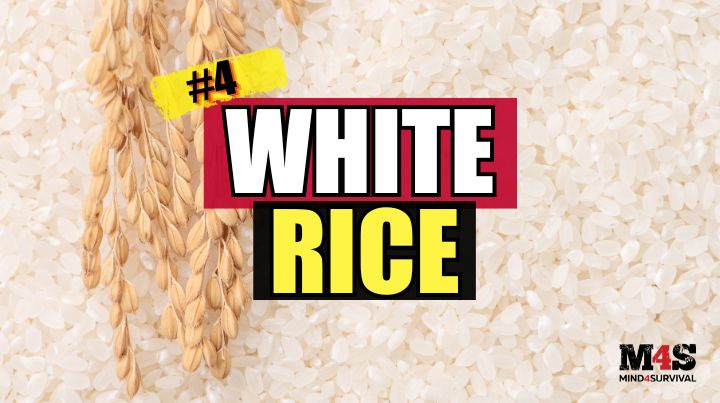
4. White Rice
White rice is well-known for its ease of cooking and extended shelf life. When adequately sealed in airtight containers and stashed in cool, dry places, white rice retains its quality for up to 30 years. In contrast, while brown rice may have a healthier profile because of its oils, those very oils shorten its shelf life, making white rice the more reliable choice for those preparing a long-term food storage pantry.
A go-to staple for centuries, white rice is a versatile base for many dishes. With just a few added ingredients, white rice can turn a simple meal into a feast. For example, add some canned meat and veggies to a bowl of fluffy white rice, and you've created a nourishing meal that could quickly become a welcomed go-to during a time of need.
When it comes to long-term food storage, where longevity and reliability are paramount, white rice should be considered a foundational ingredient in many people's long-term food pantry. However, if you or a loved one struggles with diabetes, white rice may not be your best food option. In this case, consider leaning more towards dried beans and vegetables for your carbohydrate needs.
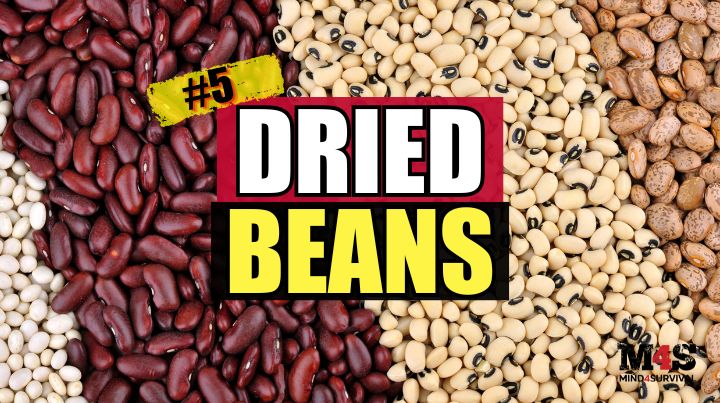
5. Dried Beans
When you think about long-term food storage, dried beans might be the superheroes of the preparedness pantry. Cheap, versatile, and packed with nutrients, they offer an impressive shelf life that makes them a staple in any preparedness-minded person's stockpile.
Dried beans are rich in protein, offering about 15 grams per cup of cooked beans, making them a superb plant-based protein source. Additionally, beans are high in dietary fiber, crucial for digestion and blood sugar regulation, with around 40 grams of carbohydrates per cup. They also provide significant amounts of vital minerals such as iron, magnesium, and potassium, which support heart health and muscle function.
Beans can last for decades when stored correctly in a cool, dry place. Their low moisture content prevents spoilage, and barring any external moisture or pests, they can be a reliable food source for decades.
Making beans even better is their ease of preparation. A simple soak and a boil can turn beans into a satisfying and nutritious meal. Their adaptability allows dried beans to mix with many of your other long-term storage foods, making them an excellent base for many emergency meals. While dried beans may not have a lot of flavor, their resilience and nutritional profile make them ideal candidates for long-term survival food.
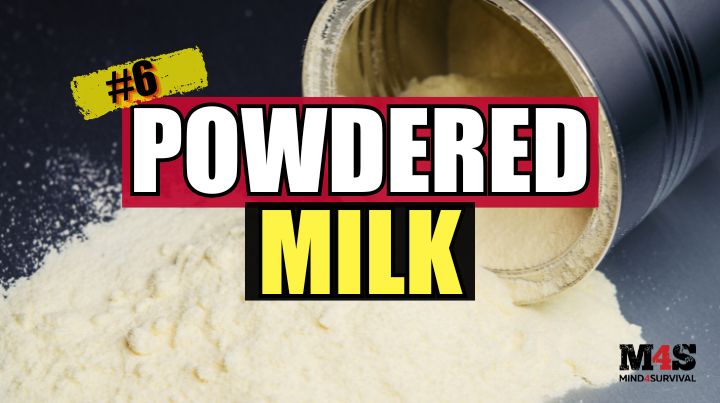
6. Powdered Milk
In the absence of fresh milk, powdered milk is a nutritious and long-lasting dairy alternative. While not as tasty as fresh milk, it's a great resource when it is too costly or unavailable.
Adequately stored in cool, dry conditions such as mylar bags, powdered milk will stay safe and nutritious well past its best-by date and upwards of 20 years. Its extended usability makes it an excellent disaster food option. A single serving of 1/3 cup of dry powdered milk yields roughly 1 cup of reconstituted milk, providing about 8 grams of protein, 80 calories, and nearly 30% of the recommended daily calcium intake.
Preparing powdered milk is quick and easy. Mix 1 cup of water with 1/3 cup of powdered milk, and it'll be ready to use like fresh milk. This ease of use makes it an ideal choice when resources and time are scarce.
Besides being a nutritious drink, powdered milk's versatility makes it an excellent addition to your long-term storage food supplies. In addition to drinking and adding it to the breakfast meal, you can use it in baking, cooking, and even making dairy products at home.
For example, you cook rice in water and add powdered milk at the end to make creamy rice porridge. You can also sweeten it with honey or sugar and add fruit. Likewise, cooking rice with milk and sugar can make a tasty dessert such as rice pudding.
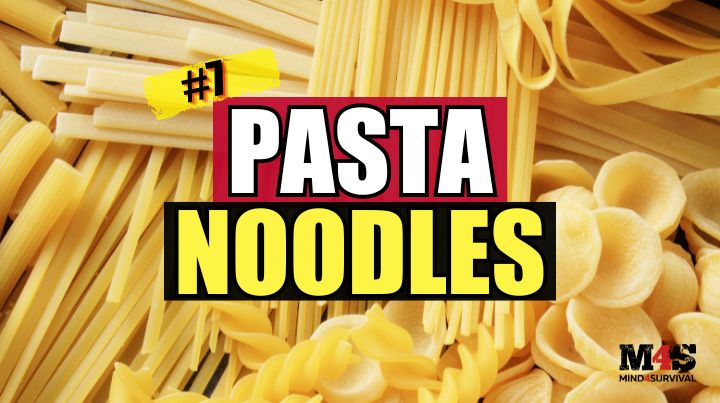
7. Pasta
Pasta is another excellent addition to your long-term survival food supply.
Due to its low moisture content, dry pasta offers an extended shelf life when stored properly. Pasta will typically last about two years in the store's packaging. However, when stored correctly in a cool, dry, and dark place in airtight containers such as mylar bags with oxygen absorbers, pasta can last 30 years or more if conditions are ideal.
The edible life span of pasta does not mean it doesn't have potential problems. Pests and improper storage conditions can turn this would-be infinite shelf-life food into an inedible waster. Therefore, check it regularly and rotate your stock to ensure your pasta remains edible and ready to go.
Pasta's versatility and ease of preparation make it an excellent choice for your emergency food pantry. That's because pasta comes in various forms—spaghetti, macaroni, and others—and offers different meal options. Cook up some pasta, add some chopped meat and vegetables, and you'll have a warm and comforting meal.
While pasta is excellent on many food fronts, it does have a drawback for some. That drawback is that pasta is typically made of durum wheat, which has a high gluten content. Therefore, if you or a loved one is sensitive to gluten, consider other long-term food storage options when creating your stockpile.
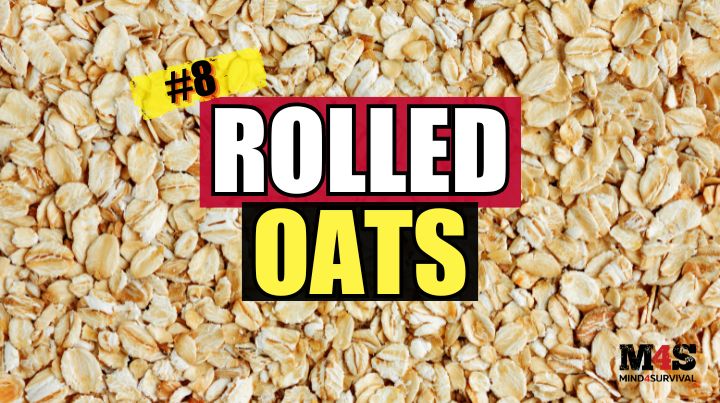
8. Rolled Oats
Rolled oats, more commonly referred to as good old-fashioned oatmeal, not only make a great breakfast, but they are also an exceptional survival food known for their impressive shelf life and robust nutritional profile.
When stored properly in cool, dry conditions within airtight containers such as mylar bags, the shelf-life of rolled oats can be significantly extended beyond their best-by date. Stored correctly, they can last up to 25-30 years.
While rolled oats are versatile, rice and pasta are more versatile because they can be combined with most long-term storage foods. However, rolled oats' mild flavor makes them an excellent base for simple oatmeal, granola, and other baked goods. Likewise, their mild nature reduces the likelihood of dietary discomfort, making rolled oats suitable for those with sensitive digestive systems or specific food intolerances.

9. Salt
Salt is beneficial for long-term survival situations due to its indefinite shelf life and essential role in nutrition and food preservation.
As a mineral, salt is composed of sodium chloride (NaCL), which is vital for maintaining the body's fluid balance and proper cell function. It also acts as an electrolyte, helping to regulate nerve and muscle function.
Before modern times, salt was so essential for food preservation that wars, such as the 16th-century Salt Wars in the Republic of Venice and the Texas Salt War of 1877, have occurred over it. Salt works as a food preservative by killing bacteria by drawing moisture out of microbial cells through osmosis, effectively dehydrating and killing them. This property makes salt an excellent preservative for meats and fish, particularly in environments where refrigeration is unavailable.
For optimal long-term salt storage, store salt in a cool, dry place away from sunlight. Use airtight containers like glass jars or food-grade buckets with mylar bags to prevent moisture from affecting the salt. As a word of caution, avoiding metal containers when storing salt is crucial, as salt can corrode them.

10. Honey
As a natural sweetener, honey is well-known for its longevity due to its natural preservatives and lack of water. Produced by bees from the nectar of flowers, honey is virtually imperishable when stored in a sealed container.
Honey's longevity stems from its acidic pH level and low moisture content, which deter the growth of bacteria, microbes, and fungi. Honey's stability makes it an excellent resource for long-term food storage, providing a durable food source and a variety of uses in emergencies.
In addition to its fantastic natural taste, honey has antiseptic properties that can be used for medicinal purposes, such as treating wounds and burns, boosting energy levels, and soothing sore throats—making it a valuable item in any survival pantry.

11. Sugar
The benefits of sugar make it an excellent choice for inclusion in a long-term food storage stockpile. Unlike many food items that degrade over time, sugar's simplicity in chemical structure ensures it can remain stable indefinitely if stored properly. This stability is because sugar does not support microbial growth, primarily due to its low moisture content, depriving bacteria and fungi of the water they need to survive.
Sugar's versatility extends its usefulness beyond just a sweetener that will help maintain a sense of normalcy during a disaster. It not only serves as a calorie-dense food that provides quick energy but also as a preservative for fruits and jams. This makes sugar a multifunctional resource in survival scenarios, offering more than just sweetness to your survival pantry.

12. Instant Coffee
While I prefer a good cup of freshly ground and brewed coffee, instant coffee has its place in a long-term storage plan.
Instant coffee stands out for its incredibly long shelf life, ensuring you'll have a comforting and energizing cup of joe for years to come. Unlike many perishable items, instant coffee is freeze-dried, which removes its moisture and retains its flavor and potency for decades when appropriately stored in a cool, dark area, away from the sun and moisture.
In addition to its comforting smell and taste, instant coffee provides a boost of caffeine, which can be vital during emergencies for maintaining alertness and reducing the physical effects of stress and fatigue.
Instant coffee is manufactured by brewing coffee in bulk and then freeze or spray-drying the liquid so that it turns into the granules we dump in cups. The instant coffee granules are then ready to reconstitute quickly with the addition of hot water, providing a welcome, comforting, and stimulating drink with minimal preparation.
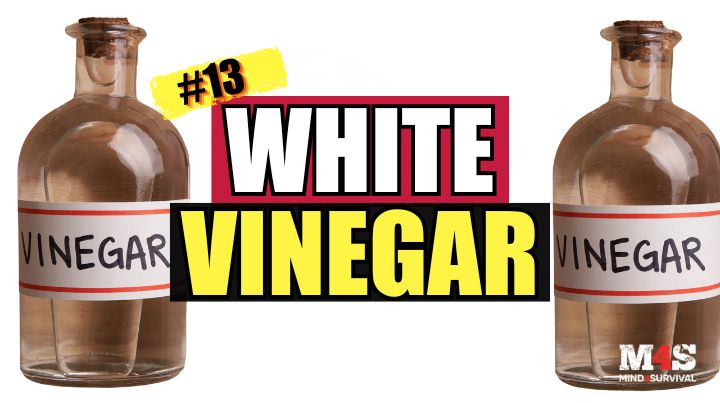
13. White Vinegar
White vinegar, with its practically infinite shelf life, is a kitchen staple and an essential part of your emergency supplies. Comprised mainly of acetic acid and water, it retains its potency over time, thanks in part to its acidic nature that hampers the growth of bacteria and other pathogens that typically spoil food products.
White vinegar is highly versatile. It is helpful for food preservation and cooking and is an effective cleaner and disinfectant. Its acetic acid content breaks down dirt and grease, making it great for cleaning surfaces. It also has antibacterial properties that help disinfect areas, reducing the spread of disease.
Additionally, white vinegar has antiseptic properties, making it useful for medical purposes. For example, it can be diluted to treat minor cuts and skin irritations and promote healing.
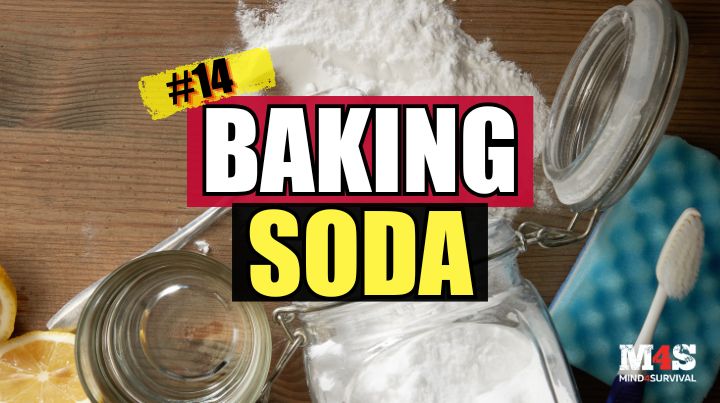
14. Baking Soda
Baking soda, also known as sodium bicarbonate, is an excellent addition to long-term food storage. Its chemical stability makes it resistant to spoilage, offering hard-to-match longevity.
This white powder is commonly known for its role in baking. It acts as a leavening agent, helping dough rise by releasing carbon dioxide. Beyond its baking uses, baking soda is practical in survival situations because of its versatility.
It can be used as a makeshift toothpaste or deodorant, providing basic hygiene solutions when traditional products are unavailable. Additionally, it offers medicinal properties, such as soothing upset stomachs and treating insect bites, making it a valuable addition to any emergency health kit.
Its gentle abrasive quality also makes it suitable for cleaning tasks, from scrubbing utensils to freshening up living spaces. Moreover, baking soda's ability to neutralize acidic substances can help with chemical spill emergencies.

15. Alcohol
While often overlooked or scoffed at as a survival staple, alcohol's properties make it a valuable addition to any preparedness strategy. Alcohol, such as vodka, known for its high ethanol content, has an indefinite shelf life, especially when kept in its original container, which prevents spoilage.
Besides filling a need for those who like to drink it, alcohol serves multiple roles in survival situations. It is an effective antiseptic for treating wounds when medical supplies are scarce. Additionally, alcohol can be used as a fuel source, powering certain stoves and lamps while providing necessary heat and light.
Furthermore, in the context of bartering, alcohol's value cannot be overstated. In times of crisis, commodities that offer comfort or medical benefits, such as alcohol, can become highly sought after. This makes it a potentially powerful trade item, helping procure other essential supplies.
The Bottom Line on Long-Term Foods to Stockpile
When creating your emergency food stockpile, it's crucial to stock up on some of these long-lasting food options. If you're a preparedness-minded person who wants to be ready for the next emergency, having a supply of durable, nutritious food will give you peace of mind, knowing that you and your loved ones will be ready when the worst happens.
The wide range of food options discussed here, from various canned meats to dried beans and instant coffee, shows that eating during a disaster doesn't have to be dull and miserable. By incorporating these easy-to-acquire, budget-friendly food options into your pantry, you'll be ready to successfully overcome any situation that comes your way.
Lastly, if you have something I missed on this list or a good way of increasing your storage that can benefit others, please leave a comment below.
Additional Resources:
- Food Preps 2.0 with Shelby Gallagher
- Food Preservation: Fermentation
- Best Foods to Stockpile for an Emergency Food Supply (2023)
- 9 Foods That Almost Never Go Bad
Stay safe,

Related Articles
FREE Guide
Read the Best Seller
Join Mind4Survival
Stay informed by joining the Mind4Survival! 100% Secure! 0% Spam!
Affiliate Disclosure...
Mind4Survival is a free, reader supported information resource. If you make a purchase through our link, we may, at no cost to your, receive an affiliate commission.
Do You Want To Be Ready No Matter What?
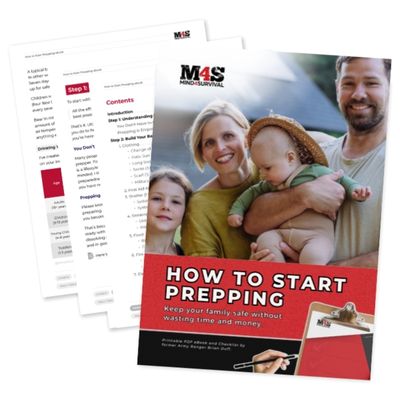
Download our free 39-page guide with interactive, 7-Day Emergency Kit Checklist and take the first step toward real preparedness.
- Know exactly where to start.
- Save time and money.
- How-to build a complete Basic Emergency Kit.
- Level up your safety and security.
Join Mind4Survival
Stay informed by joining the Mind4Survival! 100% Secure! 0% Spam!




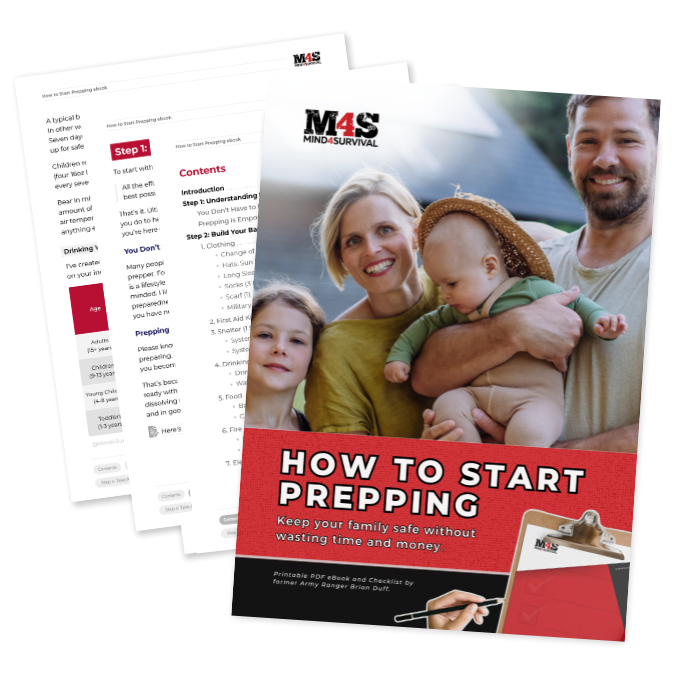

Your dietary preferences are nearly the same as mine. I also love SPAM and have found a very close and cheaper alternative in the same shaped can at Aldi. I agree with the recommendation on salt also and am presently listening to an Audio book called “The Salt Fix” that states the real culprit for bad health is sugar, not salt. Good episode, again.
Thanks for the feedback! Yes, sugar is no bueno!